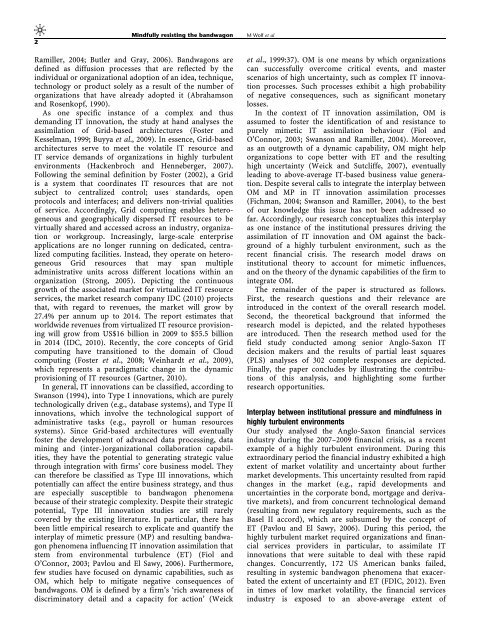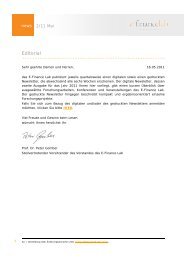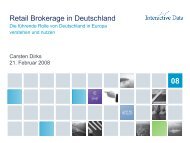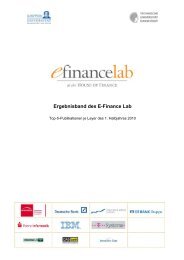Prof. Dr. Wolfgang König, Prof. Dr.-Ing. Ralf ... - E-Finance Lab
Prof. Dr. Wolfgang König, Prof. Dr.-Ing. Ralf ... - E-Finance Lab
Prof. Dr. Wolfgang König, Prof. Dr.-Ing. Ralf ... - E-Finance Lab
Create successful ePaper yourself
Turn your PDF publications into a flip-book with our unique Google optimized e-Paper software.
2<br />
Mindfully resisting the bandwagon M Wolf et al<br />
Ramiller, 2004; Butler and Gray, 2006). Bandwagons are<br />
defined as diffusion processes that are reflected by the<br />
individual or organizational adoption of an idea, technique,<br />
technology or product solely as a result of the number of<br />
organizations that have already adopted it (Abrahamson<br />
and Rosenkopf, 1990).<br />
As one specific instance of a complex and thus<br />
demanding IT innovation, the study at hand analyses the<br />
assimilation of Grid-based architectures (Foster and<br />
Kesselman, 1999; Buyya et al., 2009). In essence, Grid-based<br />
architectures serve to meet the volatile IT resource and<br />
IT service demands of organizations in highly turbulent<br />
environments (Hackenbroch and Henneberger, 2007).<br />
Following the seminal definition by Foster (2002), a Grid<br />
is a system that coordinates IT resources that are not<br />
subject to centralized control; uses standards, open<br />
protocols and interfaces; and delivers non-trivial qualities<br />
of service. Accordingly, Grid computing enables heterogeneous<br />
and geographically dispersed IT resources to be<br />
virtually shared and accessed across an industry, organization<br />
or workgroup. Increasingly, large-scale enterprise<br />
applications are no longer running on dedicated, centralized<br />
computing facilities. Instead, they operate on heterogeneous<br />
Grid resources that may span multiple<br />
administrative units across different locations within an<br />
organization (Strong, 2005). Depicting the continuous<br />
growth of the associated market for virtualized IT resource<br />
services, the market research company IDC (2010) projects<br />
that, with regard to revenues, the market will grow by<br />
27.4% per annum up to 2014. The report estimates that<br />
worldwide revenues from virtualized IT resource provisioning<br />
will grow from US$16 billion in 2009 to $55.5 billion<br />
in 2014 (IDC, 2010). Recently, the core concepts of Grid<br />
computing have transitioned to the domain of Cloud<br />
computing (Foster et al., 2008; Weinhardt et al., 2009),<br />
which represents a paradigmatic change in the dynamic<br />
provisioning of IT resources (Gartner, 2010).<br />
In general, IT innovations can be classified, according to<br />
Swanson (1994), into Type I innovations, which are purely<br />
technologically driven (e.g., database systems), and Type II<br />
innovations, which involve the technological support of<br />
administrative tasks (e.g., payroll or human resources<br />
systems). Since Grid-based architectures will eventually<br />
foster the development of advanced data processing, data<br />
mining and (inter-)organizational collaboration capabilities,<br />
they have the potential to generating strategic value<br />
through integration with firms’ core business model. They<br />
can therefore be classified as Type III innovations, which<br />
potentially can affect the entire business strategy, and thus<br />
are especially susceptible to bandwagon phenomena<br />
because of their strategic complexity. Despite their strategic<br />
potential, Type III innovation studies are still rarely<br />
covered by the existing literature. In particular, there has<br />
been little empirical research to explicate and quantify the<br />
interplay of mimetic pressure (MP) and resulting bandwagon<br />
phenomena influencing IT innovation assimilation that<br />
stem from environmental turbulence (ET) (Fiol and<br />
O’Connor, 2003; Pavlou and El Sawy, 2006). Furthermore,<br />
few studies have focused on dynamic capabilities, such as<br />
OM, which help to mitigate negative consequences of<br />
bandwagons. OM is defined by a firm’s ‘rich awareness of<br />
discriminatory detail and a capacity for action’ (Weick<br />
et al., 1999:37). OM is one means by which organizations<br />
can successfully overcome critical events, and master<br />
scenarios of high uncertainty, such as complex IT innovation<br />
processes. Such processes exhibit a high probability<br />
of negative consequences, such as significant monetary<br />
losses.<br />
In the context of IT innovation assimilation, OM is<br />
assumed to foster the identification of and resistance to<br />
purely mimetic IT assimilation behaviour (Fiol and<br />
O’Connor, 2003; Swanson and Ramiller, 2004). Moreover,<br />
as an outgrowth of a dynamic capability, OM might help<br />
organizations to cope better with ET and the resulting<br />
high uncertainty (Weick and Sutcliffe, 2007), eventually<br />
leading to above-average IT-based business value generation.<br />
Despite several calls to integrate the interplay between<br />
OM and MP in IT innovation assimilation processes<br />
(Fichman, 2004; Swanson and Ramiller, 2004), to the best<br />
of our knowledge this issue has not been addressed so<br />
far. Accordingly, our research conceptualizes this interplay<br />
as one instance of the institutional pressures driving the<br />
assimilation of IT innovation and OM against the background<br />
of a highly turbulent environment, such as the<br />
recent financial crisis. The research model draws on<br />
institutional theory to account for mimetic influences,<br />
and on the theory of the dynamic capabilities of the firm to<br />
integrate OM.<br />
The remainder of the paper is structured as follows.<br />
First, the research questions and their relevance are<br />
introduced in the context of the overall research model.<br />
Second, the theoretical background that informed the<br />
research model is depicted, and the related hypotheses<br />
are introduced. Then the research method used for the<br />
field study conducted among senior Anglo-Saxon IT<br />
decision makers and the results of partial least squares<br />
(PLS) analyses of 302 complete responses are depicted.<br />
Finally, the paper concludes by illustrating the contributions<br />
of this analysis, and highlighting some further<br />
research opportunities.<br />
Interplay between institutional pressure and mindfulness in<br />
highly turbulent environments<br />
Our study analysed the Anglo-Saxon financial services<br />
industry during the 2007–2009 financial crisis, as a recent<br />
example of a highly turbulent environment. During this<br />
extraordinary period the financial industry exhibited a high<br />
extent of market volatility and uncertainty about further<br />
market developments. This uncertainty resulted from rapid<br />
changes in the market (e.g., rapid developments and<br />
uncertainties in the corporate bond, mortgage and derivative<br />
markets), and from concurrent technological demand<br />
(resulting from new regulatory requirements, such as the<br />
Basel II accord), which are subsumed by the concept of<br />
ET (Pavlou and El Sawy, 2006). During this period, the<br />
highly turbulent market required organizations and financial<br />
services providers in particular, to assimilate IT<br />
innovations that were suitable to deal with these rapid<br />
changes. Concurrently, 172 US American banks failed,<br />
resulting in systemic bandwagon phenomena that exacerbated<br />
the extent of uncertainty and ET (FDIC, 2012). Even<br />
in times of low market volatility, the financial services<br />
industry is exposed to an above-average extent of








